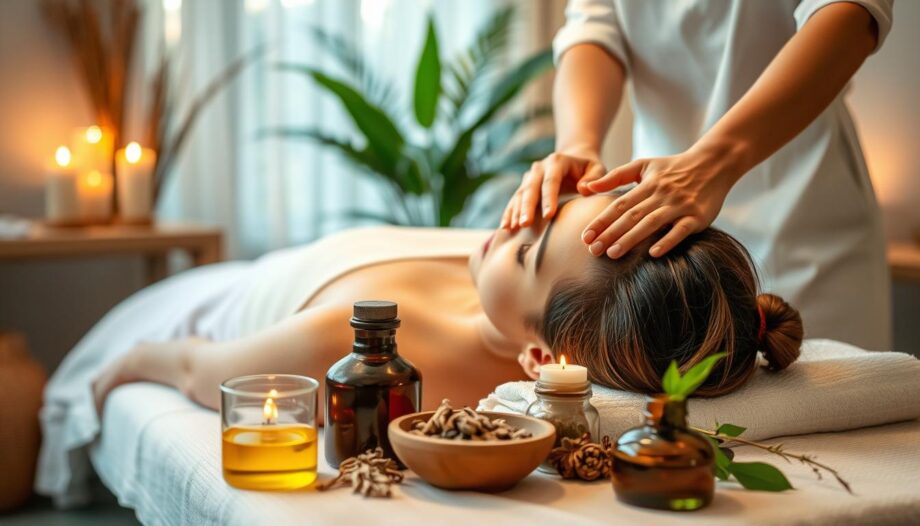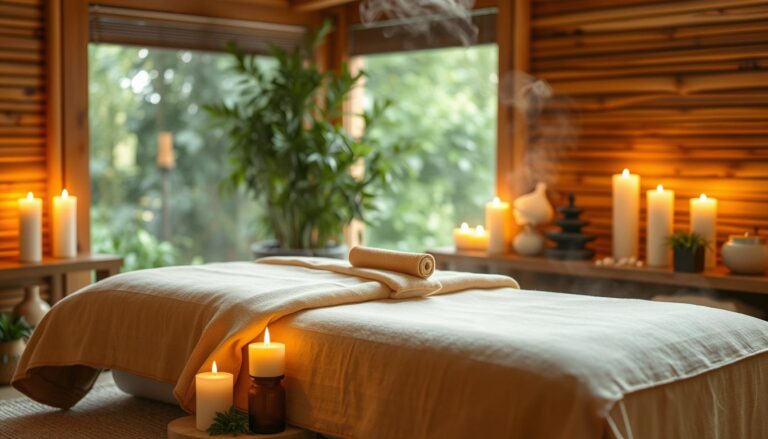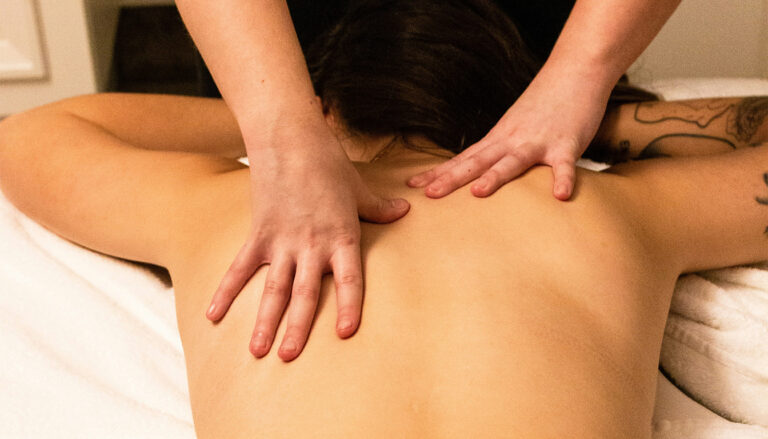Discover the ancient art of Ayurvedic head massage, a 5,000-year-old practice from India. It focuses on the head, shoulders, and neck. It uses pressure and circular strokes for benefits like pain relief and stress reduction. Experience its restorative power and find balance and vibrancy.
Ayurvedic head massage, or Shiroabhyanga, is a centuries-old tradition. It promotes relaxation and eases tension. It’s based on Ayurveda, a natural healing system from India, known worldwide for its deep effects1.
This massage targets the head, neck, and shoulders’ energy centres. It aims to rebalance the body’s doshas, which affect our health and spirit. Warm oils and gentle strokes help release stress and boost blood flow1.
Understanding the Ancient Practice of Ayurvedic Head Massage
Ayurvedic head massage, or Shiro Abhyanga, is a key part of Ayurveda. It aims to balance the body’s chakra energy points, especially those on the head. These points are linked to the brain and mind2.
Origins and Traditional Significance
Ayurvedic head massage comes from India’s rich traditional medicine. It focuses on the whole person – body, mind, and spirit3.
Key Principles of Ayurvedic Head Treatment
This massage uses special oils, pressure points, and techniques for health2. It involves circular strokes on the forehead, temples, and neck2. It’s best to leave oil on the scalp for hours or overnight. Wash with gentle shampoo and avoid hot water2.
Role in Holistic Wellness
Ayurvedic head massage balances energy, boosts organ function, and controls hormones2. It’s part of a wellness routine for stress relief and overall health4.
| Ayurvedic Head Massage Techniques | Key Benefits |
|---|---|
|
|
“Ayurvedic head massage is a deeply rooted practice within the holistic Indian healing system, focusing on balancing the body’s chakra energy points.”
Essential Health Benefits and Therapeutic Effects
Ayurvedic head massage brings many health benefits. It helps with pain relief, stress, and improves blood flow. Studies show it eases muscle tension and stiffness in the face, neck, and shoulders. It also boosts neck joint mobility5.
It can also help with tension headaches and eye strain. The gentle techniques used in Ayurvedic head massage can make a big difference5.
This ancient practice can also reduce depression and anxiety. It improves concentration and memory5. Ayurvedic head massage strengthens the immune system and helps with sleep, leading to deep relaxation and well-being5.
It balances the chakras and boosts self-esteem. This makes it a holistic way to improve health and feel rejuvenated.
Ayurvedic head massage is also good for the skin and hair5. The oils and massage stimulate the scalp. This leads to healthier hair growth and a glowing complexion5.
This makes it a natural, drug-free way to improve wellness.
| Ayurvedic Massage Techniques | Key Benefits |
|---|---|
| Abhyanga | One of the most widely-used Ayurvedic massages6 |
| Gandharva | Combines tactile touch and sound therapy using crystal singing bowls6 |
| Pizichilli | Involves two therapists pouring warm herbal oil continuously over the body for purification and detoxification6 |
| Podikizhi | Recommended for joint pain, inflammation, or muscle spasms, utilizing warm oil-dipped muslin cloth bags filled with medicinal herbs6 |
| Vishesh | A deep-tissue massage that uses minimal oil and focuses on slow, penetrating strokes for muscle relief and relaxation6 |
| Shirodhara | Involves pouring warm medicated oil onto the forehead and third eye chakra for nervous system calming and stress relief6 |
| Marma Therapy | Focuses on stimulating Marma points for natural healing and improved energy flow6 |
| Odyssey Treatment | Combines five Ayurvedic techniques by two therapists, including dry-glove exfoliation, Abhyanga massage, Vishesh deep strokes, and Marma therapy6 |
Ayurvedic massage comes from ancient Indian tradition of Ayurveda, meaning “the science of life”7. These treatments aim to balance mind, body, and spirit. They consider the individual’s unique dosha and any imbalances7.
Through nourishing oils and targeted massage, Ayurvedic head massage relieves stress and boosts positive emotions. It improves overall physical and mental health7.
“Ayurvedic massage is considered preventive medicine, enhancing circulation, stimulating the lymphatic system, and revitalising the body.”
Preparing for Ayurvedic Head Massage
Getting ready for an Ayurvedic head massage is key for a great experience. Choosing the right massage oils, setting up a calm space, and having the right tools are all important. They all help make the massage truly restorative and refreshing8.
Choosing the Right Oil
Choosing the right oil for your Ayurvedic head massage is important. Oils like sesame, coconut, almond, and olive are popular. Each oil has its own benefits8. Warming the oil can make the massage even more relaxing and help it soak into your scalp and hair better8.
Creating the Perfect Environment
The setting for your Ayurvedic head massage is very important. Dim lights, soft music, and a comfy chair or table help create a peaceful space. This lets you fully enjoy the preparation for massage89.
Required Tools and Materials
To have a smooth and effective Ayurvedic head massage, you need a few things. A soft towel to keep your clothes clean, a bowl for the oil, and a comfy chair or table are essential8. Also, using traditional Ayurvedic powder Rasnadi choornam on specific points can add extra benefits9.
| Tool/Material | Purpose |
|---|---|
| Soft Towel | Protect clothing from oil |
| Oil Bowl | Contain and apply massage oil |
| Comfortable Chair | Provide a relaxing setting |
| Rasnadi Choornam | Apply to marma points |
“Preparation is the key to a truly restorative Ayurvedic head massage experience.”
Step-by-Step Massage Techniques
Start your Ayurvedic head massage journey with these steps. First, apply a nourishing oil to your shoulders and neck. Use soothing squeezing and circular motions to massage the trapezius muscle, a key area for tension relief10.
Then, gently massage the neck with gentle pressure and kneading. Tilt your head forward and backward to target the base of the skull. This helps increase mobility and release10.
Next, apply oil to your scalp and use shampooing-like motions to stimulate pressure points. Rub the scalp vigorously with your fingertips, to improve blood circulation and feel rejuvenated10.
To finish, use smooth strokes from your forehead to the back of your head. Always check if the pressure feels right for a personal touch10.
| Massage Technique | Benefits |
|---|---|
| Circular motions on trapezius muscle | Relieves pain and stiffness in muscles10 |
| Kneading and gentle pressure on neck | Increases mobility of neck joints10 |
| Vigorous scalp massage | Improves blood circulation and scalp health10 |
| Smooth strokes from forehead to back of head | Promotes a sense of tranquility and well-being10 |
These Ayurvedic massage techniques offer deep benefits. They can relieve pain, improve mobility, and bring balance and calm1011.
“Ayurvedic head massage is a truly transformative experience, offering a holistic approach to wellness that nourishes the body, mind, and spirit.”
Incorporating Daily Self-Massage Practices
Adding Ayurvedic head massage to your daily routine can boost its benefits. Begin with a quick morning massage, targeting the scalp, temples, and neck12. This can be done in under 15 minutes, helping you start the day feeling refreshed12.
Quick Techniques for Busy Schedules
If your days are packed, try quick self-massage methods. Simple scalp or temple rubs can fit into your work breaks12. Even short sessions can help reduce stress and improve your mood13.
Maintenance and Frequency Guidelines
Adjust how often you massage yourself based on your lifestyle13. Try to do it a few times a week to keep up the good work of Ayurvedic massage13. Experiment with oils like sesame, coconut, almond, or jojoba to find the right one for you12. Regular, even brief, massages can lead to better sleep, less stress, and a happier you13.
FAQ
What is Ayurvedic head massage?
Ayurvedic head massage is a 5000-year-old treatment from India. It uses pressure and circular strokes on the head, shoulders, and neck. It helps with pain, improves movement, reduces stress, and boosts sleep and well-being.
What are the key principles of Ayurvedic head massage?
It’s based on Ayurveda, an ancient Indian healing system. It aims to balance energy points, especially on the head. This practice focuses on physical, mental, and spiritual health, using oils and specific techniques.
What are the health benefits of Ayurvedic head massage?
It relieves muscle pain and stiffness, improves neck mobility, and eases headaches and eye strain. It also reduces depression, anxiety, and improves sleep, immune system, and skin and hair health. It brings tranquility and boosts self-esteem.
How should I prepare for an Ayurvedic head massage?
Choose the right oils like sesame or coconut, warmed for comfort. Create a calm space with dim lights and music. Use a towel, a bowl for oil, and a comfy chair. Rasnadi choornam powder can be used on marma points.
What are the key steps in an Ayurvedic head massage?
Start with oil on shoulders and neck, using squeezing and circular motions. Massage the neck and skull base. Tilt the head gently. Apply oil to the scalp and rub vigorously. Finish with smooth strokes from forehead to back.
How can I integrate Ayurvedic head massage into my daily routine?
Start with a morning massage on key points. For busy days, try quick scalp or temple rubs. Aim for regular, even brief massages. Adjust frequency based on your lifestyle, but aim for at least a few times a week.





